Financial Accounting and Reporting Report: Case Studies & Analysis
VerifiedAdded on 2023/04/04
|6
|1294
|222
Report
AI Summary
This report provides an overview of Financial Accounting and Reporting, focusing on AASB standards, specifically AASB 137 and 138. The report defines contingent liabilities and explains their accounting treatment, including disclosure requirements. It presents a case study involving a lawsuit against a company and analyzes the potential impact on financial statements. The report also covers the recognition of internally generated intangible assets under AASB 138, comparing them to acquired intangibles and discussing factors influencing managerial decisions regarding asset capitalization and amortization. The report concludes with a discussion on the complexities of accounting for intangible assets and their impact on financial reporting, supported by references to relevant literature and standards.
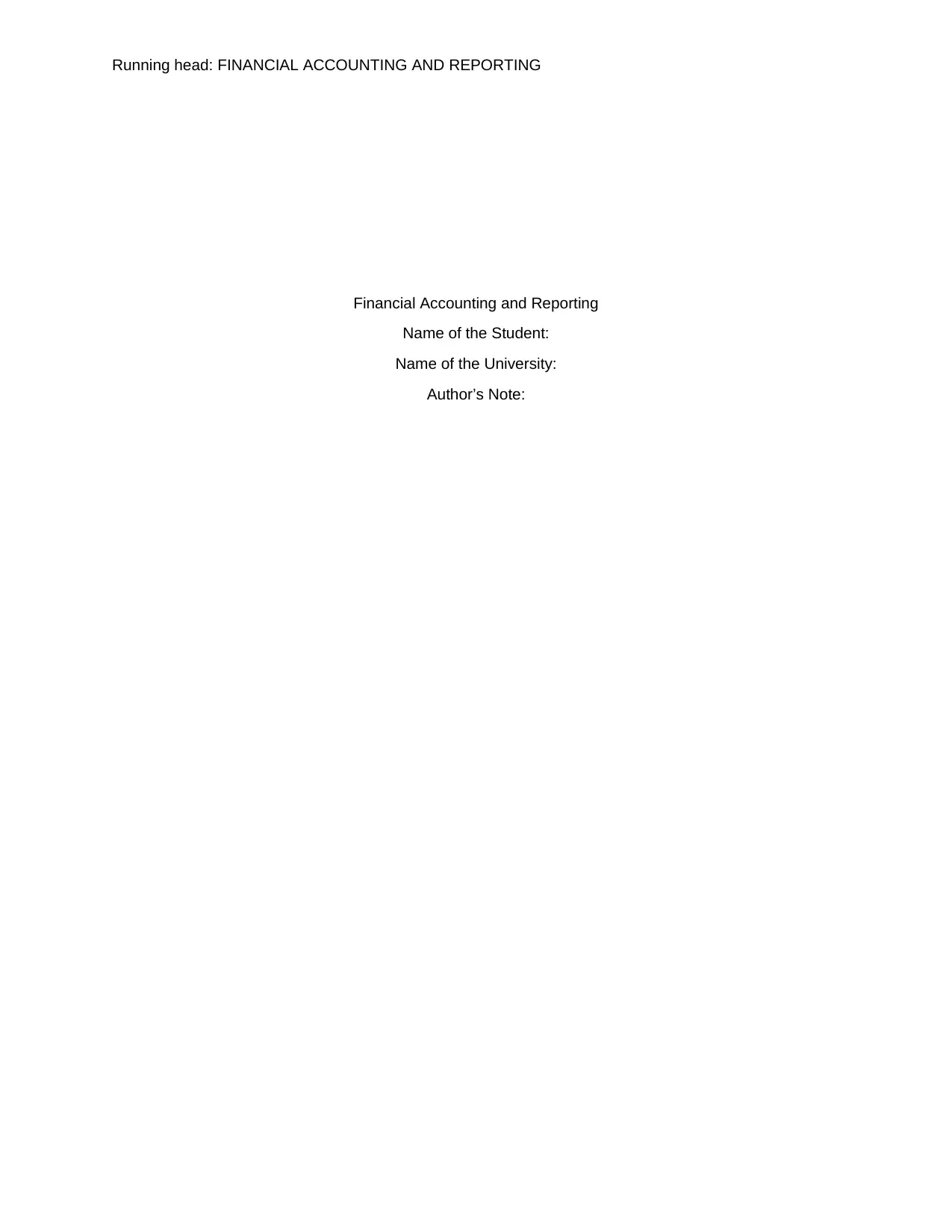
Running head: FINANCIAL ACCOUNTING AND REPORTING
Financial Accounting and Reporting
Name of the Student:
Name of the University:
Author’s Note:
Financial Accounting and Reporting
Name of the Student:
Name of the University:
Author’s Note:
Paraphrase This Document
Need a fresh take? Get an instant paraphrase of this document with our AI Paraphraser
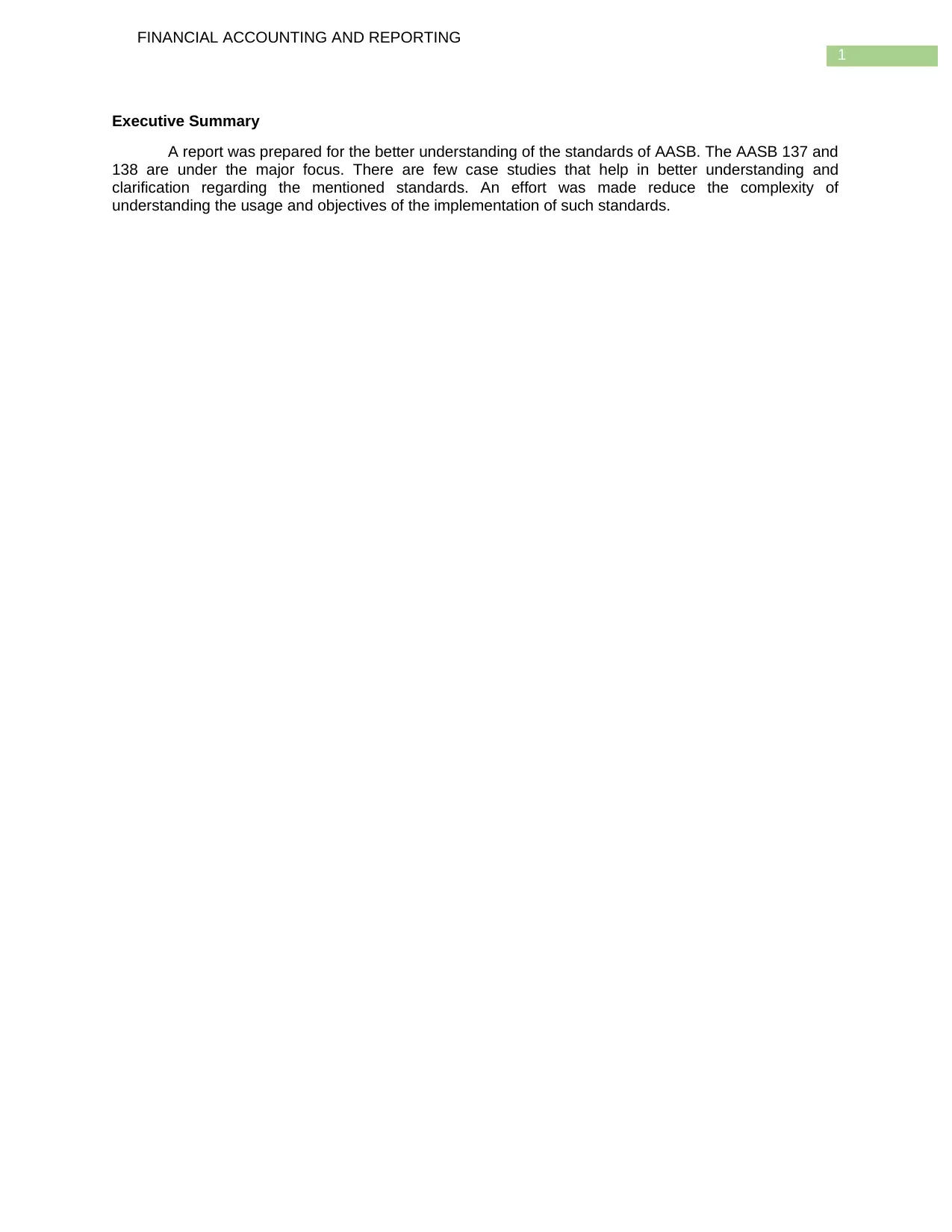
1
FINANCIAL ACCOUNTING AND REPORTING
Executive Summary
A report was prepared for the better understanding of the standards of AASB. The AASB 137 and
138 are under the major focus. There are few case studies that help in better understanding and
clarification regarding the mentioned standards. An effort was made reduce the complexity of
understanding the usage and objectives of the implementation of such standards.
FINANCIAL ACCOUNTING AND REPORTING
Executive Summary
A report was prepared for the better understanding of the standards of AASB. The AASB 137 and
138 are under the major focus. There are few case studies that help in better understanding and
clarification regarding the mentioned standards. An effort was made reduce the complexity of
understanding the usage and objectives of the implementation of such standards.
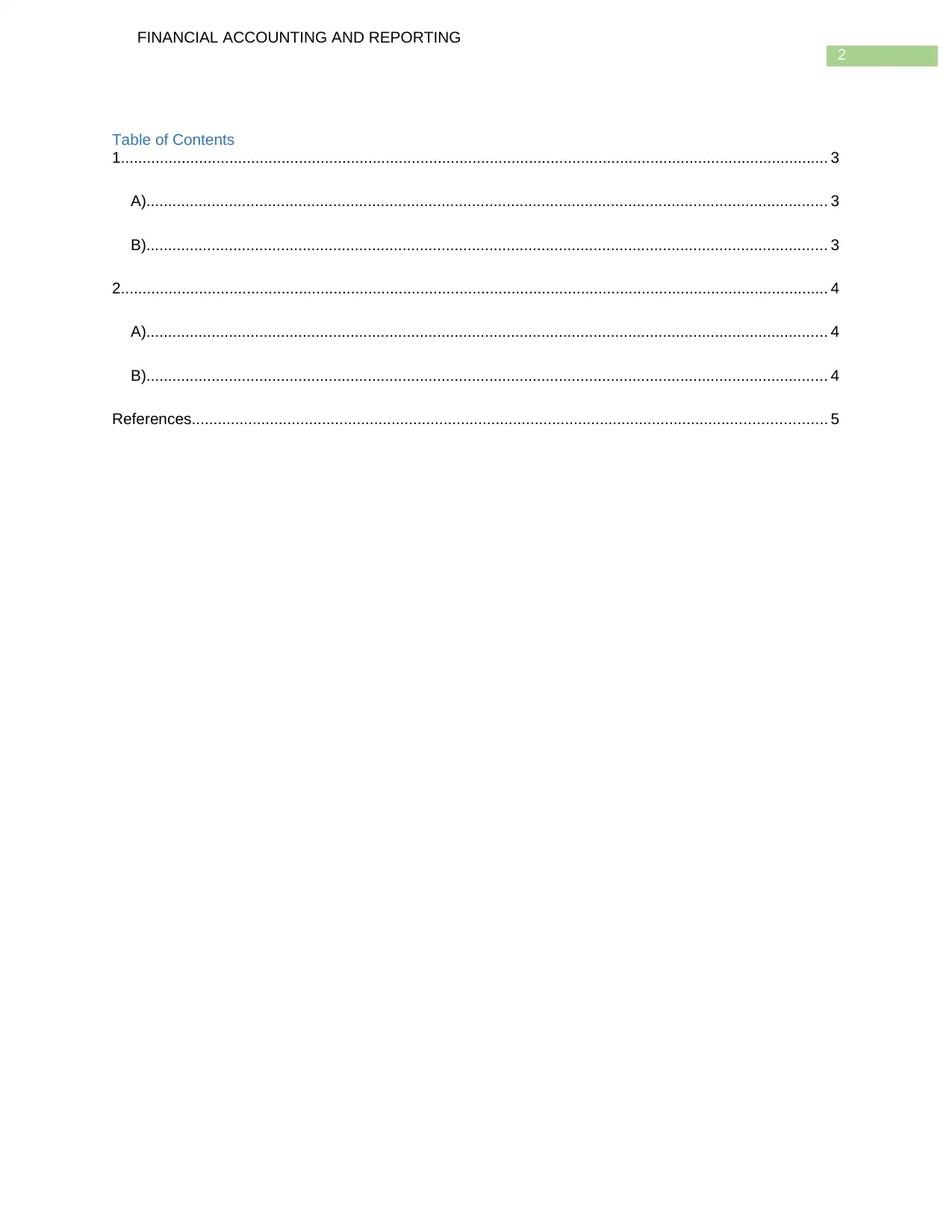
2
FINANCIAL ACCOUNTING AND REPORTING
Table of Contents
1................................................................................................................................................................... 3
A)............................................................................................................................................................. 3
B)............................................................................................................................................................. 3
2................................................................................................................................................................... 4
A)............................................................................................................................................................. 4
B)............................................................................................................................................................. 4
References.................................................................................................................................................. 5
FINANCIAL ACCOUNTING AND REPORTING
Table of Contents
1................................................................................................................................................................... 3
A)............................................................................................................................................................. 3
B)............................................................................................................................................................. 3
2................................................................................................................................................................... 4
A)............................................................................................................................................................. 4
B)............................................................................................................................................................. 4
References.................................................................................................................................................. 5
⊘ This is a preview!⊘
Do you want full access?
Subscribe today to unlock all pages.

Trusted by 1+ million students worldwide
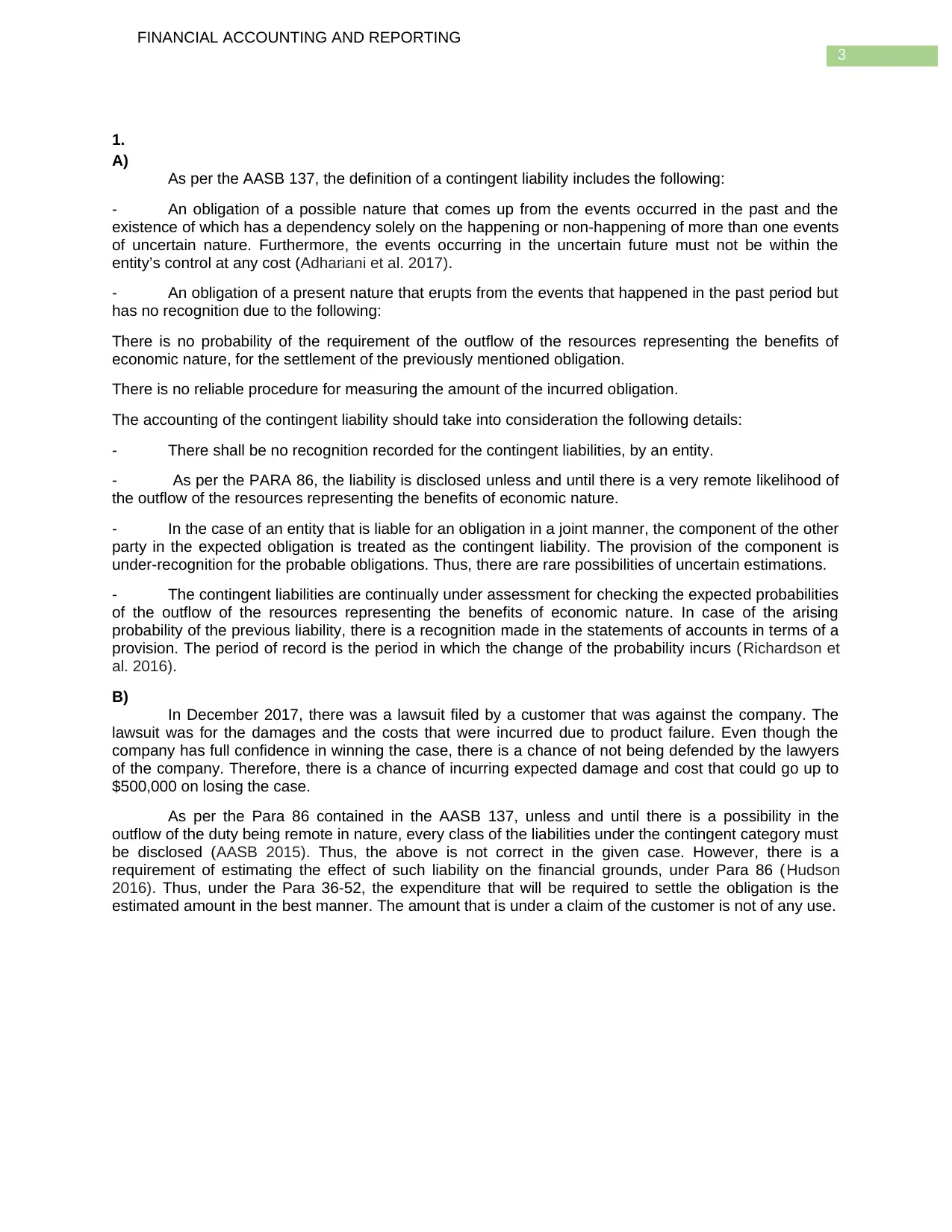
3
FINANCIAL ACCOUNTING AND REPORTING
1.
A)
As per the AASB 137, the definition of a contingent liability includes the following:
- An obligation of a possible nature that comes up from the events occurred in the past and the
existence of which has a dependency solely on the happening or non-happening of more than one events
of uncertain nature. Furthermore, the events occurring in the uncertain future must not be within the
entity’s control at any cost (Adhariani et al. 2017).
- An obligation of a present nature that erupts from the events that happened in the past period but
has no recognition due to the following:
There is no probability of the requirement of the outflow of the resources representing the benefits of
economic nature, for the settlement of the previously mentioned obligation.
There is no reliable procedure for measuring the amount of the incurred obligation.
The accounting of the contingent liability should take into consideration the following details:
- There shall be no recognition recorded for the contingent liabilities, by an entity.
- As per the PARA 86, the liability is disclosed unless and until there is a very remote likelihood of
the outflow of the resources representing the benefits of economic nature.
- In the case of an entity that is liable for an obligation in a joint manner, the component of the other
party in the expected obligation is treated as the contingent liability. The provision of the component is
under-recognition for the probable obligations. Thus, there are rare possibilities of uncertain estimations.
- The contingent liabilities are continually under assessment for checking the expected probabilities
of the outflow of the resources representing the benefits of economic nature. In case of the arising
probability of the previous liability, there is a recognition made in the statements of accounts in terms of a
provision. The period of record is the period in which the change of the probability incurs ( Richardson et
al. 2016).
B)
In December 2017, there was a lawsuit filed by a customer that was against the company. The
lawsuit was for the damages and the costs that were incurred due to product failure. Even though the
company has full confidence in winning the case, there is a chance of not being defended by the lawyers
of the company. Therefore, there is a chance of incurring expected damage and cost that could go up to
$500,000 on losing the case.
As per the Para 86 contained in the AASB 137, unless and until there is a possibility in the
outflow of the duty being remote in nature, every class of the liabilities under the contingent category must
be disclosed (AASB 2015). Thus, the above is not correct in the given case. However, there is a
requirement of estimating the effect of such liability on the financial grounds, under Para 86 ( Hudson
2016). Thus, under the Para 36-52, the expenditure that will be required to settle the obligation is the
estimated amount in the best manner. The amount that is under a claim of the customer is not of any use.
FINANCIAL ACCOUNTING AND REPORTING
1.
A)
As per the AASB 137, the definition of a contingent liability includes the following:
- An obligation of a possible nature that comes up from the events occurred in the past and the
existence of which has a dependency solely on the happening or non-happening of more than one events
of uncertain nature. Furthermore, the events occurring in the uncertain future must not be within the
entity’s control at any cost (Adhariani et al. 2017).
- An obligation of a present nature that erupts from the events that happened in the past period but
has no recognition due to the following:
There is no probability of the requirement of the outflow of the resources representing the benefits of
economic nature, for the settlement of the previously mentioned obligation.
There is no reliable procedure for measuring the amount of the incurred obligation.
The accounting of the contingent liability should take into consideration the following details:
- There shall be no recognition recorded for the contingent liabilities, by an entity.
- As per the PARA 86, the liability is disclosed unless and until there is a very remote likelihood of
the outflow of the resources representing the benefits of economic nature.
- In the case of an entity that is liable for an obligation in a joint manner, the component of the other
party in the expected obligation is treated as the contingent liability. The provision of the component is
under-recognition for the probable obligations. Thus, there are rare possibilities of uncertain estimations.
- The contingent liabilities are continually under assessment for checking the expected probabilities
of the outflow of the resources representing the benefits of economic nature. In case of the arising
probability of the previous liability, there is a recognition made in the statements of accounts in terms of a
provision. The period of record is the period in which the change of the probability incurs ( Richardson et
al. 2016).
B)
In December 2017, there was a lawsuit filed by a customer that was against the company. The
lawsuit was for the damages and the costs that were incurred due to product failure. Even though the
company has full confidence in winning the case, there is a chance of not being defended by the lawyers
of the company. Therefore, there is a chance of incurring expected damage and cost that could go up to
$500,000 on losing the case.
As per the Para 86 contained in the AASB 137, unless and until there is a possibility in the
outflow of the duty being remote in nature, every class of the liabilities under the contingent category must
be disclosed (AASB 2015). Thus, the above is not correct in the given case. However, there is a
requirement of estimating the effect of such liability on the financial grounds, under Para 86 ( Hudson
2016). Thus, under the Para 36-52, the expenditure that will be required to settle the obligation is the
estimated amount in the best manner. The amount that is under a claim of the customer is not of any use.
Paraphrase This Document
Need a fresh take? Get an instant paraphrase of this document with our AI Paraphraser
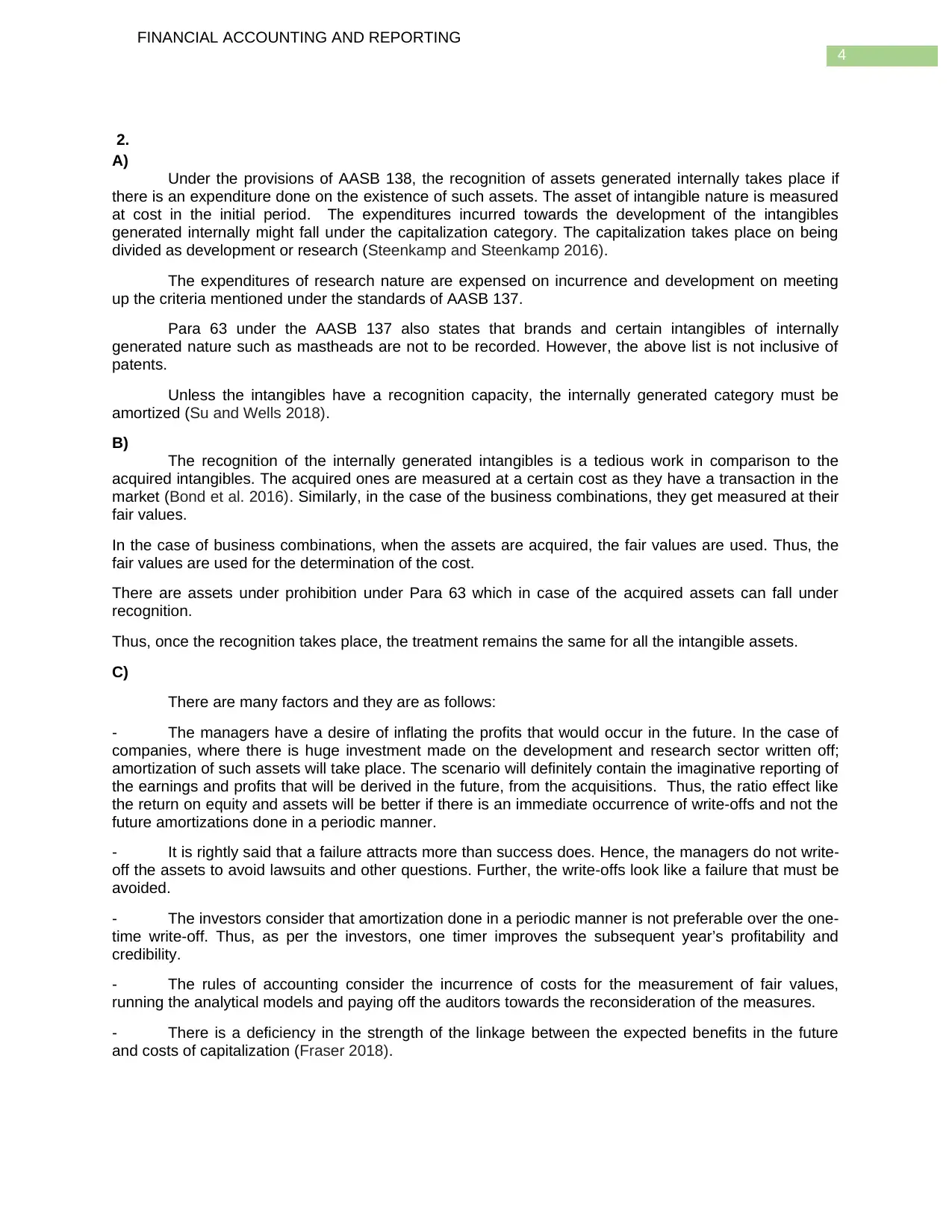
4
FINANCIAL ACCOUNTING AND REPORTING
2.
A)
Under the provisions of AASB 138, the recognition of assets generated internally takes place if
there is an expenditure done on the existence of such assets. The asset of intangible nature is measured
at cost in the initial period. The expenditures incurred towards the development of the intangibles
generated internally might fall under the capitalization category. The capitalization takes place on being
divided as development or research (Steenkamp and Steenkamp 2016).
The expenditures of research nature are expensed on incurrence and development on meeting
up the criteria mentioned under the standards of AASB 137.
Para 63 under the AASB 137 also states that brands and certain intangibles of internally
generated nature such as mastheads are not to be recorded. However, the above list is not inclusive of
patents.
Unless the intangibles have a recognition capacity, the internally generated category must be
amortized (Su and Wells 2018).
B)
The recognition of the internally generated intangibles is a tedious work in comparison to the
acquired intangibles. The acquired ones are measured at a certain cost as they have a transaction in the
market (Bond et al. 2016). Similarly, in the case of the business combinations, they get measured at their
fair values.
In the case of business combinations, when the assets are acquired, the fair values are used. Thus, the
fair values are used for the determination of the cost.
There are assets under prohibition under Para 63 which in case of the acquired assets can fall under
recognition.
Thus, once the recognition takes place, the treatment remains the same for all the intangible assets.
C)
There are many factors and they are as follows:
- The managers have a desire of inflating the profits that would occur in the future. In the case of
companies, where there is huge investment made on the development and research sector written off;
amortization of such assets will take place. The scenario will definitely contain the imaginative reporting of
the earnings and profits that will be derived in the future, from the acquisitions. Thus, the ratio effect like
the return on equity and assets will be better if there is an immediate occurrence of write-offs and not the
future amortizations done in a periodic manner.
- It is rightly said that a failure attracts more than success does. Hence, the managers do not write-
off the assets to avoid lawsuits and other questions. Further, the write-offs look like a failure that must be
avoided.
- The investors consider that amortization done in a periodic manner is not preferable over the one-
time write-off. Thus, as per the investors, one timer improves the subsequent year’s profitability and
credibility.
- The rules of accounting consider the incurrence of costs for the measurement of fair values,
running the analytical models and paying off the auditors towards the reconsideration of the measures.
- There is a deficiency in the strength of the linkage between the expected benefits in the future
and costs of capitalization (Fraser 2018).
FINANCIAL ACCOUNTING AND REPORTING
2.
A)
Under the provisions of AASB 138, the recognition of assets generated internally takes place if
there is an expenditure done on the existence of such assets. The asset of intangible nature is measured
at cost in the initial period. The expenditures incurred towards the development of the intangibles
generated internally might fall under the capitalization category. The capitalization takes place on being
divided as development or research (Steenkamp and Steenkamp 2016).
The expenditures of research nature are expensed on incurrence and development on meeting
up the criteria mentioned under the standards of AASB 137.
Para 63 under the AASB 137 also states that brands and certain intangibles of internally
generated nature such as mastheads are not to be recorded. However, the above list is not inclusive of
patents.
Unless the intangibles have a recognition capacity, the internally generated category must be
amortized (Su and Wells 2018).
B)
The recognition of the internally generated intangibles is a tedious work in comparison to the
acquired intangibles. The acquired ones are measured at a certain cost as they have a transaction in the
market (Bond et al. 2016). Similarly, in the case of the business combinations, they get measured at their
fair values.
In the case of business combinations, when the assets are acquired, the fair values are used. Thus, the
fair values are used for the determination of the cost.
There are assets under prohibition under Para 63 which in case of the acquired assets can fall under
recognition.
Thus, once the recognition takes place, the treatment remains the same for all the intangible assets.
C)
There are many factors and they are as follows:
- The managers have a desire of inflating the profits that would occur in the future. In the case of
companies, where there is huge investment made on the development and research sector written off;
amortization of such assets will take place. The scenario will definitely contain the imaginative reporting of
the earnings and profits that will be derived in the future, from the acquisitions. Thus, the ratio effect like
the return on equity and assets will be better if there is an immediate occurrence of write-offs and not the
future amortizations done in a periodic manner.
- It is rightly said that a failure attracts more than success does. Hence, the managers do not write-
off the assets to avoid lawsuits and other questions. Further, the write-offs look like a failure that must be
avoided.
- The investors consider that amortization done in a periodic manner is not preferable over the one-
time write-off. Thus, as per the investors, one timer improves the subsequent year’s profitability and
credibility.
- The rules of accounting consider the incurrence of costs for the measurement of fair values,
running the analytical models and paying off the auditors towards the reconsideration of the measures.
- There is a deficiency in the strength of the linkage between the expected benefits in the future
and costs of capitalization (Fraser 2018).
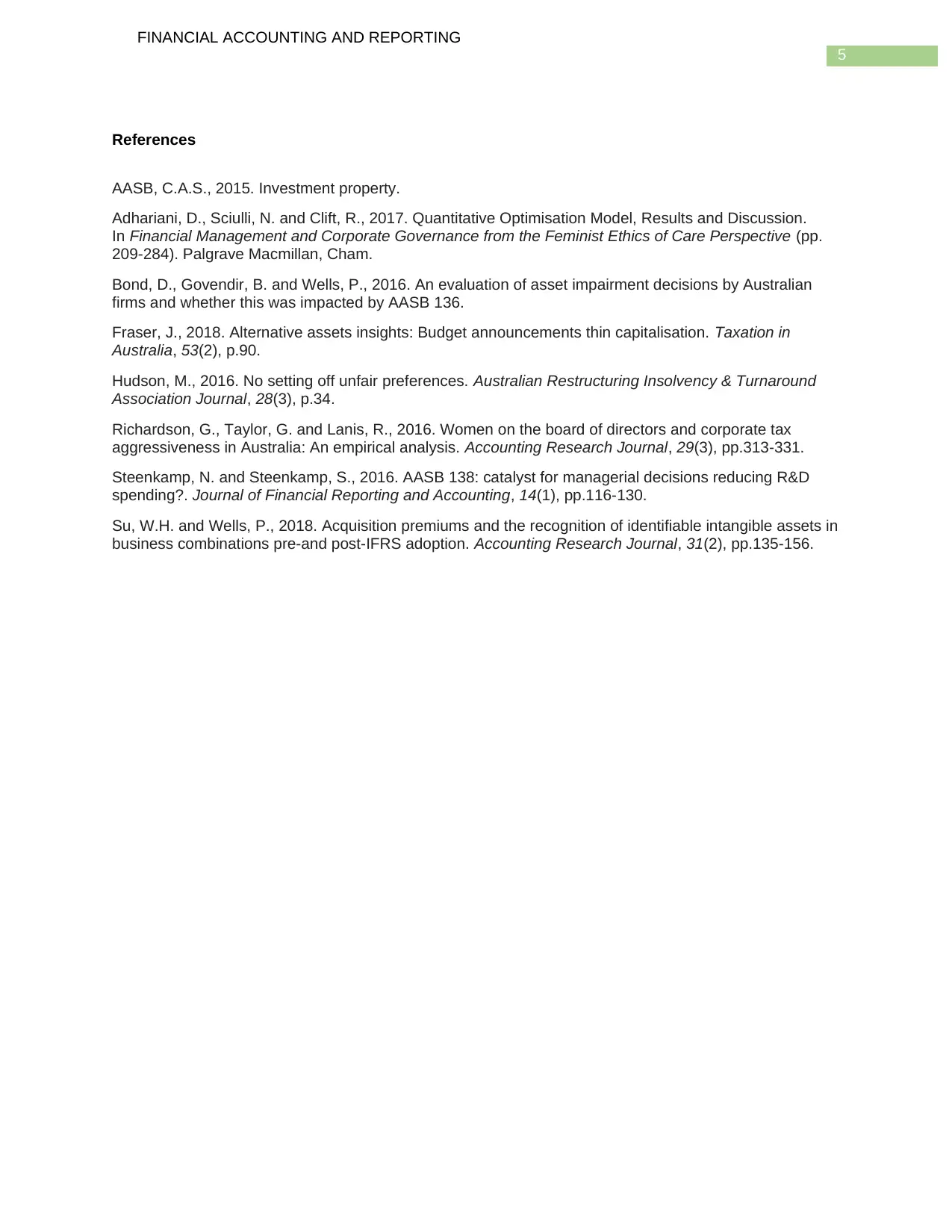
5
FINANCIAL ACCOUNTING AND REPORTING
References
AASB, C.A.S., 2015. Investment property.
Adhariani, D., Sciulli, N. and Clift, R., 2017. Quantitative Optimisation Model, Results and Discussion.
In Financial Management and Corporate Governance from the Feminist Ethics of Care Perspective (pp.
209-284). Palgrave Macmillan, Cham.
Bond, D., Govendir, B. and Wells, P., 2016. An evaluation of asset impairment decisions by Australian
firms and whether this was impacted by AASB 136.
Fraser, J., 2018. Alternative assets insights: Budget announcements thin capitalisation. Taxation in
Australia, 53(2), p.90.
Hudson, M., 2016. No setting off unfair preferences. Australian Restructuring Insolvency & Turnaround
Association Journal, 28(3), p.34.
Richardson, G., Taylor, G. and Lanis, R., 2016. Women on the board of directors and corporate tax
aggressiveness in Australia: An empirical analysis. Accounting Research Journal, 29(3), pp.313-331.
Steenkamp, N. and Steenkamp, S., 2016. AASB 138: catalyst for managerial decisions reducing R&D
spending?. Journal of Financial Reporting and Accounting, 14(1), pp.116-130.
Su, W.H. and Wells, P., 2018. Acquisition premiums and the recognition of identifiable intangible assets in
business combinations pre-and post-IFRS adoption. Accounting Research Journal, 31(2), pp.135-156.
FINANCIAL ACCOUNTING AND REPORTING
References
AASB, C.A.S., 2015. Investment property.
Adhariani, D., Sciulli, N. and Clift, R., 2017. Quantitative Optimisation Model, Results and Discussion.
In Financial Management and Corporate Governance from the Feminist Ethics of Care Perspective (pp.
209-284). Palgrave Macmillan, Cham.
Bond, D., Govendir, B. and Wells, P., 2016. An evaluation of asset impairment decisions by Australian
firms and whether this was impacted by AASB 136.
Fraser, J., 2018. Alternative assets insights: Budget announcements thin capitalisation. Taxation in
Australia, 53(2), p.90.
Hudson, M., 2016. No setting off unfair preferences. Australian Restructuring Insolvency & Turnaround
Association Journal, 28(3), p.34.
Richardson, G., Taylor, G. and Lanis, R., 2016. Women on the board of directors and corporate tax
aggressiveness in Australia: An empirical analysis. Accounting Research Journal, 29(3), pp.313-331.
Steenkamp, N. and Steenkamp, S., 2016. AASB 138: catalyst for managerial decisions reducing R&D
spending?. Journal of Financial Reporting and Accounting, 14(1), pp.116-130.
Su, W.H. and Wells, P., 2018. Acquisition premiums and the recognition of identifiable intangible assets in
business combinations pre-and post-IFRS adoption. Accounting Research Journal, 31(2), pp.135-156.
⊘ This is a preview!⊘
Do you want full access?
Subscribe today to unlock all pages.

Trusted by 1+ million students worldwide
1 out of 6
Related Documents
Your All-in-One AI-Powered Toolkit for Academic Success.
+13062052269
info@desklib.com
Available 24*7 on WhatsApp / Email
![[object Object]](/_next/static/media/star-bottom.7253800d.svg)
Unlock your academic potential
Copyright © 2020–2026 A2Z Services. All Rights Reserved. Developed and managed by ZUCOL.





